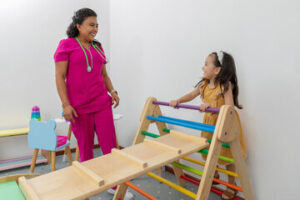Pediatric Occupational Therapy is designed to help children improve their ability to participate in daily activities and develop the skills necessary for socialization and school readiness. OT Montgomery County evaluate the reasons behind any difficulties and focus on underlying skills that may be causing these delays.

Pediatric Occupational Therapy is an approach that takes into account a client’s entire life. This includes their mental and emotional health as well as their physical wellbeing. The treatment helps children develop skills that enable them to live their lives in a way that is meaningful and fulfilling, regardless of any limitations they may face.
Whether it’s a child with autism spectrum disorder, Down syndrome, cerebral palsy, or a physical impairment from a car accident or injury, an occupational therapist can help them learn new skills and get back to doing the things they love most, such as playing with their friends and learning in school. They also work with children to learn how to perform daily tasks, such as dressing and eating.
A recent study analyzing interviews with occupational therapists found that there were three main themes that emerged: (1) holism as both a broad and narrow concept, (2) being holistic spans from treating body parts to teaching marginalized children, and (3) it’s a lot to ask. These themes illustrate the challenges that occupational therapists face when attempting to work holistically.
To overcome these challenges, the researchers suggest a pragmatic epistemology that is sensitive to diversity. This includes focusing on what is important to the client and using an activity-based model of practice that is grounded in the context of everyday life. This will help to foster more holistic practice and improve the outcomes of interventions.
The authors of this paper argue that occupational therapy is uniquely positioned to promote development for all children as new service delivery models are established for pediatric primary care. They propose a set of action steps: (1) advocacy for legislation that requires developmental screenings and surveillance, (2) support of culturally responsive developmental monitoring, and (3) building evidence for occupational therapy in pediatric primary care settings.
Whether it’s helping children learn to dress themselves or use the bathroom independently, pediatric occupational therapy can improve their quality of life and give them back their confidence. But it’s important to understand that this is a process and will take time. It’s also critical to find a therapist that is a good fit for your child and your family. This will ensure a positive experience for all involved.
Occupational Therapists Help Children Develop Skills
The goal of pediatric occupational therapy is to help children develop the skills they need to grow into healthy, well-adjusted adults. These skills include a wide variety of areas, from basic motor and sensory to cognitive and social abilities. This is why it’s so important to find a practitioner with the right qualifications, training and experience to treat your child.
Occupational therapists who specialize in pediatrics have advanced degrees and extensive training that includes working with young children. They also work closely with families and other healthcare providers to support the best outcomes for their clients. They are uniquely qualified to identify and treat underlying issues that may be contributing to your child’s problems, such as emotional regulation or poor attention skills.
Pediatric OT practitioners use various techniques to help children develop essential skills that they will need throughout their lives, such as emotional and behavioral regulation, the ability to process sensory input, and fine and visual motor skills. They often incorporate play into their sessions to make them fun and engaging, which can help reduce any anxiety that a child might feel when learning new things.
These professionals often work in public and private hospitals, schools, community health centres, clinics including early intervention services, and people’s homes. The American Occupational Therapy Association has highlighted children and youth as one of its key focus areas for practice.
Pediatric occupational therapists will use their expert knowledge to determine the root cause of your child’s challenges and develop a treatment plan that addresses all underlying issues. Then, they will collaborate with other professionals like educators and psychologists to ensure that your child’s needs are met in a holistic way. This will include ensuring that their learning environment is conducive to their special needs and that they receive the support they need in school and other social environments. In addition, they will work with you to teach your child the tools and strategies that they will need to become self-sufficient adults. This includes everything from brushing their teeth and eating to playing with their friends and managing their emotions.
Occupational Therapists Help Children Learn New Skills
Pediatric Occupational Therapy can help children improve the skills they need to function in everyday life. This can include eating, bathing, using the bathroom, playing, dressing & walking. The therapist can help children with developmental delays, sensory processing issues & even physical impairments due to congenital or acquired disability.
Children learn new skills in sessions that are fun & engaging. They work with tools like finger paints, play-doh, art kits & board games to increase their fine motor skills. They may also use swings, tumbling mats & obstacle courses to help them build their gross motor skills. The therapist will assess the child to determine their needs & goals. They will create a customized treatment plan based on the assessment & develop an outcome evaluation to see how well they are meeting those goals.
Another major focus of OT is helping children socialize with their peers. This can be difficult for kids with developmental disabilities & can cause them to have low self-esteem. The therapist will work on activities that encourage the child to interact with their peers, such as role-playing & other games. They will also try to help the child build coping strategies that can be used when they are not in the presence of their peers.
Some children need to learn how to calm their bodies down & become more regulated. These kids might have trouble focusing in class or might be overwhelmed by loud noises or itchy tags. The therapist will help the child develop strategies that can be used when they are stressed or overwhelmed. They will also teach the child how to engage in self-calming techniques, such as breathing exercises & meditation. This will help the child to refocus their attention when they are ready to participate in class again. The therapist will also encourage the child to practice these activities at home with their family so they can continue to grow their skills.
Occupational Therapists Help Children Develop Independence
Occupational therapy helps children develop independence in daily self-care activities like dressing, grooming, and eating. Getting children to practice these skills and become more independent is important for their physical, social, emotional and cognitive development. They can also become less reliant on caregivers, which can lead to improved relationships with family members and other peers and ultimately improve academic performance in school.
The first session is usually an evaluation, where the therapist will observe your child doing a few simple tasks in their natural environment and learn more about the challenges they are facing. The therapist will then decide on some goals that they want to work on with your child in the future.
After the evaluation your therapist will plan their sessions around the goals that they have decided on. They will use a variety of techniques, including sensory integration therapy and therapeutic listening treatment to help your child overcome the challenges they are facing. For example, if your child has a sensory processing disorder it might be difficult for them to handle the different textures of clothing or other materials, which may cause them to resist activities like brushing their teeth or getting dressed. The OT will use different techniques to help them get used to these things and they will be able to perform the activity with less resistance.
In addition to working with children in a clinic setting, pediatric occupational therapists also work with children at home through community outreach programs and private practice settings. They can also work in an inpatient hospital setting with children who are experiencing a life threatening illness or injury.
Overall, pediatric occupational therapy can be very beneficial for children who have a wide range of conditions, including autism spectrum disorder, Down syndrome, cerebral palsy and even after a brain injury or stroke. It can help them overcome their challenges and reach their full potential, both in school and in life outside of the classroom. It is important to remember that OT takes time and patience, but it can be very rewarding for both the client and their parents.
